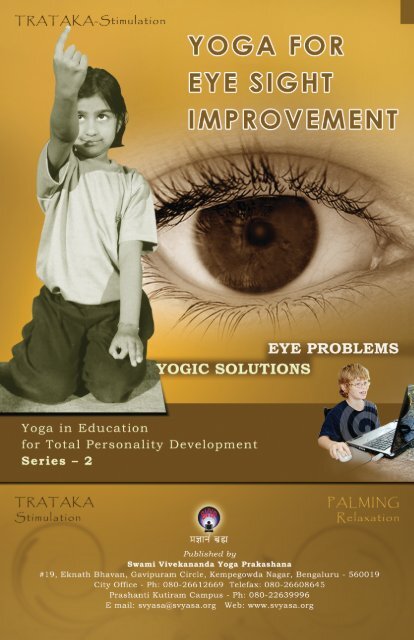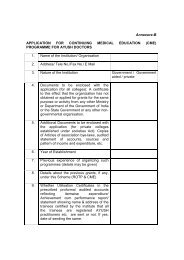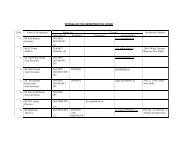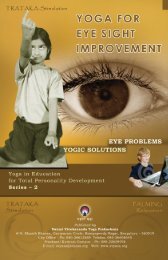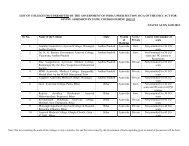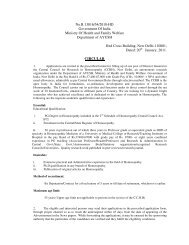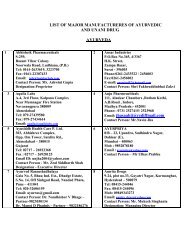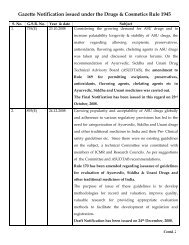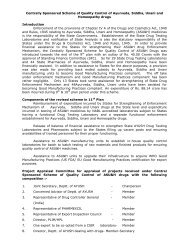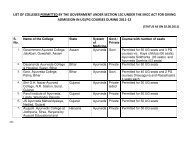Yoga for Stress Management
Yoga for Stress Management
Yoga for Stress Management
- No tags were found...
Create successful ePaper yourself
Turn your PDF publications into a flip-book with our unique Google optimized e-Paper software.
ContentsCh.No. title Page No.1 Introduction2 Body Systems in ImprovingPhysical Stamina3 Physiology of Muscle Action4 Physical Stamina According to <strong>Yoga</strong>5 <strong>Yoga</strong> Practices <strong>for</strong>Physical Stamina Development
8 | <strong>Yoga</strong> <strong>for</strong> <strong>Stress</strong> <strong>Management</strong>around us. After four centuries we are in a fundamental positionwhere we understand almost everything about the physical world.We know that every object is made of molecules and atoms, whichin turn are made out of neutrons, protons and the electrons and fundamentalparticles. What are these fundamental particles made of?The fundamental particles are made out of energy, packets of energycalled photons. So we know that everything in the physical world isnothing but energy. We can precisely calculate how much energy isthere in a given matter E=MC2. Then we also understood the lawsthat govern them. The laws of the physical world are pronouncedby Newton mechanics, Pascal mechanics. Newton’s Law of Motionthat we all studied in high school days. But as we enter into specialdimension, extremely high speed like electron wheeling round thenucleolus, Newtonian, Pascal mechanism cannot explain. One needto go to the quantum mechanics. Now having understood the physicalworld the time has come that we have to go beyond. Now wehave reached a stage that we understood the physical world and weare in a transition to go beyond to understand prana, mind, emotionsand consciousness and it is in this region of subtlety that we have tomove.<strong>Yoga</strong> in Education <strong>for</strong> Total Personality Development SERIES - 0
10 | <strong>Yoga</strong> <strong>for</strong> <strong>Stress</strong> <strong>Management</strong>can contribute us as stressor, it is important <strong>for</strong> us to understand howwe can regulate them. This is where <strong>Yoga</strong> comes into picture in helpingus to understanding stress producing factors. <strong>Yoga</strong> also helps togive us different methodologies and techniques to manage them.Let us see how this whole concept of stresscan influence our body. As was mentioned, itinvolves three different systems to function ata given point of time. This whole process hasbeen divided into three phases. Phase one, analarm response, phase two where by an individual settles with thestressful situation whereas stage three is exertion. What the NeuroScientists believe it as general awareness syndrome. In this basicallyan individual in the first stage undergoes series of changes physiologically.This part is called as Basic <strong>Stress</strong> Response or the Flight orFight Response. Most of us have encountered this in different ways.Some of us might have just encountered early in our life whereassome others might have encountered it little later in our lives. Butstress response has become a mandatory to each and every individual.Let us see what happens when you interact with this Flightor Fight response. Basically whenever you come across a stimuluswhich demands a response from you, body prepares itself to handlethat demanding situation in the <strong>for</strong>m of physiological as well as behavioralresponses. For example, imagine you are just taking a walkin a park. Suddenly you see a snake. You have any one of thesetwo choices with you. Either you attack the snake or you run awayfrom the snake. Another most commonly observed phenomena arewhenever you are going <strong>for</strong> a walk, you have been chased by a dog.So you have once again two options. Either fight with the dog or runaway from the dog. In both the cases your body has to prepare itself<strong>Yoga</strong> in Education <strong>for</strong> Total Personality Development SERIES - 0
<strong>Yoga</strong> <strong>for</strong> <strong>Stress</strong> <strong>Management</strong> | 11to handle the situation. Let us see what all happens will happen inthe body when you are in such a situation.Three physiological processes work in conjunction to bring out aresponse. They are (1) The Nerves System, (2) The Endocrine Systemand (3) The Muscular Skeletal System. The parts of the NervesSystem which involve in regulating stress and different endocrinemechanisms will be detailed little later, be<strong>for</strong>e that let us understandhow the whole process happens.In the first part, Flight or Fight Response, here the body prepares inthree different ways. (1) It gets all the alarming inputs and it preparesthe body to handle all these situations in a way so that you canmanage it effectively. What happens basically is at the physiologicallevel whenever there is a demanding situation, your body preparesin the <strong>for</strong>m of stimulation. Stimulation makes you ready to naturalsituation. For this process Nerves System, Endocrine and the MuscularSkeletal System have to prepare. The whole Nerves System hasbeen divided into three parts. They are the Central Nerves System,Peripheral Nerve System and Autonomic Nerves System. What weare interested to look at is Autonomic Nerves System which controlsthe involuntary functions. For example, the heart beating even whenyou are sleeping, the respiration continues and the digestive activitiesgoes on even when you are sleeping even when we are not consciousof these functions.<strong>Yoga</strong> in Education <strong>for</strong> Total Personality Development SERIES - 0
12 | <strong>Yoga</strong> <strong>for</strong> <strong>Stress</strong> <strong>Management</strong>PHYSIOLOGICAL CHANGESDUE TO STRESSBe<strong>for</strong>e we go on to any of the other details, let us try to understandwhat stress is all about. All of us keep hearing this terminology<strong>Stress</strong> most commonly. Somebody gets stress physically, somebodygets stress mentally, somebody feels heavy emotionally and expressthat it is highly stressful. If it is very commonly occurring phenomenonin each one of our lives, let us try to understand what exactlythe stress is all about. In simple terms <strong>Stress</strong> can be defined as ‘nonspecific basic response pattern which prepares an individual <strong>for</strong> ademanding situation’. Having been prepared, it regulates it, makesyou work at different levels so that you can handle the demandingsituation. This involves activities at physiological level, activities atthe behavioral level and modifications at the emotional response patternlevel.A stress producing factor what is called as a stressor can intervenean individual either as an external agent or as an internal agent. Externalagent can be physical in nature. It can be due to emotions. Itcan also be contributed from the society. At the same time it canalso be a combination of the above three mentioned factors. Whenwe are looking at the factors which can contribute us as stressor it isimportant <strong>for</strong> us to understand how we can regulate them. This iswhere <strong>Yoga</strong> comes into picture of helping us to understand stress<strong>Yoga</strong> in Education <strong>for</strong> Total Personality Development SERIES - 0
<strong>Yoga</strong> <strong>for</strong> <strong>Stress</strong> <strong>Management</strong> | 13producing factors to begin with and then different methodologiesand different techniques to manage them.Let us see how this whole concept of stress can influence our body.As has been mentioned it involves three different systems to functionat a given point of time. This whole process has been divided intothree phases. Phase one, an alarm response, phase two, where byan individual settles with the stressful situation whereas stage threeis exertion. What the cognitive Neuron Scientists believe it as generalawareness syndrome. In this, basically an individual in the firststage undergoes series of changes physiologically. This part is calledas Basic <strong>Stress</strong> Response or the Flight or Fight Response. Most of ushave encountered this in different ways. Whenever there is stressfulsituation here the individual’s response starts in the <strong>for</strong>m of Arousalof Autonomic Nerves System whereby a Sympathetic Nerves Systemtakes a lead. Basically the heart starts beating faster. One startsbreathing quicker in order to take more oxygen to supply to the demandingparts, pupils dilate so that visual perception becomes more<strong>Yoga</strong> in Education <strong>for</strong> Total Personality Development SERIES - 0
14 | <strong>Yoga</strong> <strong>for</strong> <strong>Stress</strong> <strong>Management</strong>sharper. The blood supply to skeletal muscles increases so that themuscles are strong enough to handle the situation. At the same timeother systems like the Digestive system etc., they withdraw theirfunctioning in terms of reduced blood supply etc. To do this taskyou need more energy. Hence the glucose in the blood increaseswhereby it is available to handle the situation. So overall there is anArousal. The muscles are ready, heart will be beating faster so thatmore blood goes there, more oxygen is available in terms of breathing.Vision becomes sharper. Everything is ready to handle thatstressful situation.Imagine if this continues <strong>for</strong> a long duration, the body cannot copeup. Instead if there is a withdrawal of stressful stimulus the bodyslowly comes back to its base line. As was mentioned earlier, supposeone has been chased by dog, now what happens suddenly becausehe person appear to be stronger, the dogs run away. So nowthe body understands that there is no more threatening situation. Soyou can relax yourself. It comes back to its base line. Having beencome to base line, now the life continues. Imagine if this repeatsagain and again that is what has been observed in the present daythat we undergo stressful situations quite frequently say that we arenot giving our body enough time <strong>for</strong> it to come back to its normalbase line, hence resulting in the phase of exertion. Taking care of allthese three phases of <strong>Stress</strong> will lead to a positive stress which can beused <strong>for</strong> developing better skills. If the three phases of stress are nottaken care, they can lead to chronic stress.<strong>Yoga</strong> in Education <strong>for</strong> Total Personality Development SERIES - 0
<strong>Yoga</strong> <strong>for</strong> <strong>Stress</strong> <strong>Management</strong> | 15STRESS MANAGEMENTIn the last Chapter we discussed how stress is multidimensionaland <strong>Yoga</strong> can offer a solution to this multidimensional challenge.Because <strong>Yoga</strong> works at the Body level, Prana level, Mind level, Emotionallevel and the Intellectual level. The highly developed, systematicallydeveloped Jnana <strong>Yoga</strong>, Raja <strong>Yoga</strong>, Bhakti <strong>Yoga</strong> and Karma<strong>Yoga</strong> work at all these levels to bring solutions to the challenge ofstress. An Integrated <strong>Yoga</strong> Module that is developed is the one thatcombines the whole wisdom base of our country and applied withyoga techniques judicially to bring the results. Thousands and thousandsof people have got the solution from their stress problem. TheIntegrated <strong>Yoga</strong> Module that have presented is based on the Mundokapanishadand the commentary is written by Gowda Pada andthe Mandookya Karika. That Karika Shloka is:Laye sambodhaye chittam Vikshiptam samayet punahaSakashayam vijaniyat samapraptam nachlayetWhat does it mean? When the mind goes into drowsiness, sleepiness,lethargy, stagnation, saturation, awaken it. Don’t allow that tosleep off. Stimulate a sleeping mind. Then what is going to happen?The mind is going to go haphazard. When the mind goes random,calm down the mind, silence the mind and allow the mind to enjoy.If you do it once, the habit will die hard. There<strong>for</strong>e we have to<strong>Yoga</strong> in Education <strong>for</strong> Total Personality Development SERIES - 0
16 | <strong>Yoga</strong> <strong>for</strong> <strong>Stress</strong> <strong>Management</strong>do it again and again, again and again. Punah, Punaha, vikshiptamkshamayet he has added stimulate, relax, stimulate, relax that takesus to deeper and deeper levels of growth. Takes us to deeper levelsof our inner dimension of silence and deep rest. Then he says understandthe deeper levels of stress. Initially we start getting all the benefitsin relaxation of the body, slowing of the growth and your facewill be relaxed and you will start getting wonderful results of normalsleep and others. Then the Karika tells that you have to go deepand observe those stresses which are in the settled <strong>for</strong>m sakashayamvijaniyat and it is the deep rooted stress, it is the deep rooted imbalancethat brings about the distortion of our behavioral trends and thechanges in your personality. So one has to go deep down and changethose personality traits which we call as Samskaras Vasanas. Thereare imbalances at the deeper levels of our sub consciousness in theManomaya kosa. We have all the techniques of <strong>Yoga</strong> <strong>for</strong> cleansingusing the meditation, using pranayamas and using the techniquesof stimulation and relaxation. When we start using it we start goingdeeper and deeper and bring out all those dirt which we have accumulated<strong>for</strong> years and centuries and births and cleans ourselves.A person who was practicing the stress <strong>Yoga</strong> module said after thepractice, Sir today I had such a wonderful great blissful experienceunparallel in my life. First time I had such a blissful experience whenyou said that you merge with that totality with all pervasive beautifulsky. Yet another person came and told, Sir today I started enjoyingvery well nicely getting relaxed when you came now relaxed nicelyof the facial muscle, temple muscles and the <strong>for</strong>ehead muscle and thewhole face is something triggered in me. I suddenly became veryangry. What are these things? This is called the Kashaya. They arecalled the dirt. The dirt which is accumulated in our subconsciouswill all starts coming out and we start getting purified. I told all these<strong>Yoga</strong> in Education <strong>for</strong> Total Personality Development SERIES - 0
<strong>Yoga</strong> <strong>for</strong> <strong>Stress</strong> <strong>Management</strong> | 17people that this is what is happening. Please continue the practice,allow that to come out, allow that dirt to vanish and you will get purified.Thus continue the practice one month, one and a half month.This is the total personality trans<strong>for</strong>mation that takes place when youstart reducing the stress. There<strong>for</strong>e the Integrated <strong>Yoga</strong> Modules thatwe are offering here consists of a judicious combination of Asana, thePranayama and the Meditation which all help us to go deeper anddeeper. This removes the blocks, knots, obsessions, fovea and growto greater heights by developing sensitivity on one side and awarenesson the other side. An expanding awareness and a depth of perceptionbrought harmoniously. The module works wonderfully.<strong>Yoga</strong> in Education <strong>for</strong> Total Personality Development SERIES - 0
18 | <strong>Yoga</strong> <strong>for</strong> <strong>Stress</strong> <strong>Management</strong>STRESS MANAGEMENT<strong>Yoga</strong> <strong>for</strong> <strong>Stress</strong>. <strong>Stress</strong> is something that we find every day andeverybody is talking about stress today. What is this <strong>Stress</strong>? Howdo we understand stress? Why it is becoming a major issue in thepresent day life style? Let us try to understand this, find techniquesand learn yogic techniques of helping ourselves to be free from thiswhat could be called as monsters of present day life style. What is<strong>Stress</strong>? As soon as I ask you what is <strong>Stress</strong>, you will start wonderinghave you heard <strong>Stress</strong>. Yes. I have had lot of stress in my life. Whatare your stresses? May be your office, may be your child, difficulthusband, difficult mother, difficult family, difficult politics. So wetend to relate our stress to a mental state, a reaction, an emotion,an uncom<strong>for</strong>table feeling that is evoked by these different situations.But stress is not just that uncom<strong>for</strong>table feeling. <strong>Stress</strong> by definitionis a necessary helpful mechanism that is set into our system to beable to cope up with demanding situations of life. It is a productivemechanism. So stress is not basically a disease. <strong>Stress</strong> is notbasically only a distress. <strong>Stress</strong> is a coping helping mechanism toevoke to manage emergency situations. So <strong>for</strong> example, you are allseated here. Suddenly fire alarm comes. What have we to do? It is adangerous situation. The sound of the fire alarm falls on your ear, itgoes to your mind, you recognize it as danger and immediately a bigsurge of electrical activity comes down from the brain and stimulatesall activities of the body. To make that escape from the danger, we<strong>Yoga</strong> in Education <strong>for</strong> Total Personality Development SERIES - 0
<strong>Yoga</strong> <strong>for</strong> <strong>Stress</strong> <strong>Management</strong> | 19have to activate even if you are drowsy and sleepy. You are wokenup and you are very alert and then you start moving your limbs veryfast, your heart rate goes up, breathing goes up and just escape fromthe danger. After you have escaped from the danger, or you havegone and fought the fire, what you will do? My god, I have escapedfrom danger. You sit there, you relax, you rest and now you willstart feeling how your heart was beating, how your breathing wasso very fast and how your mind was throbbing and your head wasthrobbing and how all your muscles had become very tight and nowyou starts sweating away so that all the heat in the body starts reducing.After another 5/10 minutes you start feeling hungry. Thenyou want to sleep, rest, relax, rejuvenate and restore the system andthis is a nature’s protective mechanism a <strong>Stress</strong> Adaptation Responsewhich nature has provided <strong>for</strong> us to protect our organism from anydangerous life threatening situation. Nature has not only providedthis response software, response pattern, response programming <strong>for</strong>only physically demanding situation, but it has provided the sametype of response to emotionally demanding situations also. Likewe saw a office tension or a difficult family, difficult calamity or adifficult situation, finance crisis we get tensed up, we react, we getheightened alertness and the heart starts beating, pressure goes up,all these changes. You have to go and face the exam, face the interview.So these are emotionally demanding situations. So to these situationsalso nature does the same type of response. First at the mindlevel where we get anxious or tensed or angry or worry and this is apsychological emotional response which makes our mind very alertand then percolates into the body to bring about all these changesthat we saw in the accident fire alarm episode and once the dangeris over and the situation is over, we just restore the system. Naturehas provided a beautiful nerves and chemical mechanism to help us<strong>Yoga</strong> in Education <strong>for</strong> Total Personality Development SERIES - 0
20 | <strong>Yoga</strong> <strong>for</strong> <strong>Stress</strong> <strong>Management</strong>cope up with and that goes on very nicely. So when we want to getalert, excited, stimulated, there is one set of nerves called SympatheticNerves System which activates increases the heart rate, Bloodpressure, increases the muscle tone, increases the blood glucose leveland makes our mind very very alert and increases the sweating rate,decreases the blood that goes to the intestine so that the intestine canwait digestive activity until we escape from danger and once we areout of danger, Para Synthetic Nerves System takes over and then itrestores, rejuvenates, relaxes, reduce the heart rate, reduce the bloodpressure, improves intestinal motility, improves secretion of digestivejuices and makes our system come back to base level of working.This is a beautiful balancing mechanism. Imagine if this system wasnot there, all the time heart only functions at a level which neverincrease when required and decrease when not required. This is notwhat our system wants. We want to activate and rest and relax andrejuvenate when the system demand is over. So this process of stressadaptation is called SAS or <strong>Stress</strong> Adaptation Syndrome, <strong>Stress</strong> AdaptationMechanism which was beautifully described and elaboratedwith lots of understanding by two doctors in 1960. The famous doctorsShelly and Levy worked on this stress adaption mechanism andmade us understand Psycho Neuron Physiology. What are all thechanges that happen in our system when we get stressed up and thatmakes us understand how this stress is a useful adaptation mechanism.Then why do we call stress a dangerous thing? What is happeningin the present day life style? Let us see, we activate the system. Thereis a demanding situation that activates, heart rate goes up, bloodpressure goes up, alertness goes up and we have no time to get backto normalcy. Again another demanding situation right from morn-<strong>Yoga</strong> in Education <strong>for</strong> Total Personality Development SERIES - 0
<strong>Yoga</strong> <strong>for</strong> <strong>Stress</strong> <strong>Management</strong> | 21ing till evening until you wake up, from the time you wake up untilyou go to bed. Whole day demand and these demanding situationsare the one’s which provoke our Synthetic activity to do its job andwe have no time <strong>for</strong> the Para synthetic to rest the system, to restorethe system, rejuvenate the system, relax the system, come to baselevel of activity. Even after hectic day in the evening and when youcome home, you cannot just go back to sleep because the whole dayeight hours, ten hours, fourteen hours your system was working athigh level of activity. You come back home, you want to go to bed,sleep does not come. Why? Because the mind is so alert a habit ofactivated system is the whole of the problem that in a present day lifestyle, the fast way of life, the demanding situations packing up oneafter the other, no time <strong>for</strong> restoring the system and lead to a habit<strong>for</strong>mation and that can lead to stabilize blood pressure which remainhigh, stabilize heart rate which remains high, stabilize glucose whichbecomes high which can declare as Diabetes, hypertension etc., etc.<strong>Yoga</strong> in Education <strong>for</strong> Total Personality Development SERIES - 0
22 | <strong>Yoga</strong> <strong>for</strong> <strong>Stress</strong> <strong>Management</strong>STRESS MANAGEMENTWe have understood that stress is not an abnormality if it is used inthe right way. It is the nature’s protective necessary mechanism, areflex, a software programming that is set into our system to help uscope up with the demanding situation, elevate the blood pressure,heart rate etc. to cope up with the demanding situation with heightenedactivity of the Sympathetic Nerves System and once the situationis over, get back to normalcy which is done by ParasympatheticNerves System and we also understood that it is the habit of beingactivated all the time that is creating the problem. What can happenif the mind is all the time stimulated? First at the mind level. At themind level we start losing sleep. One day it is OK, you had manygreatly demanding situation, you will lose sleep over a very anxioussituation. The next day you will sleep off extra. That is the systemgets rejuvenated. But what is happening in the present day life style?You are not at all getting the time to get back to sleep. Through-outthe week, there is a demand to work eight hours, ten hours, fifteenhours. The more you are growing, the more you are achieving, themore you are progressing, more the demanding situation, more theproblem, more the anxiety, both in the family and in the office. Sothis can create lot of demand on our nerves system. So this can lead toa habit of the nerves system. So the very first manifestation of stressis shown up in the <strong>for</strong>m of Insomnia, sleeplessness, difficult to startsleep. You go to bed; you switch off the outside light, switch off all<strong>Yoga</strong> in Education <strong>for</strong> Total Personality Development SERIES - 0
<strong>Yoga</strong> <strong>for</strong> <strong>Stress</strong> <strong>Management</strong> | 23the outside sound, cover yourself so that all the skin input becomesoff. You are warm inside the bed, but if you want to switch off themind it won’t switch off because whole day’s activities, whole day’sstimulation, whole day speed up set of mind in which you keep yourmind has become habituated to think. What is that you need to do toswitch off the mind and sleep?First, we go to bed, put all the lights off. Remove all the stimulifrom all parts of the body, then tell yourself, let me now sleep. Thatis enough of an input, a thought in the mind which helps you to slowdown the mind and then naturally gets switched off. The sleep centregets stimulated. But you are not able to do that. Initial suggestiondoesn’t work. I want to sleep, I want to sleep, I cannot get sleep,that happened, this happened, this happened in the morning, thathappened in the morning, Mind becomes very active. Because thereare so many unsolved problems there are many pending thoughts.So mind becomes over active. You start worrying about what happenedin the morning. Somebody insulted you, somebody hurt youand some suppress feeling or worrying about the future. Tomorrowmorning I have this to solve, I have to solve that. So divert your mindbe<strong>for</strong>e going to sleep. We use to teach special techniques to all ourpatients who come here to learn yoga therapy. Most of the peoplewhether they have anxiety or back pain or neck pain have this sleepdifficulty. So what we tell them is first be<strong>for</strong>e you go to bed be<strong>for</strong>eyou switch off the lights and get into bed do little fast jagging so thatyour energy get diverted to lower parts of the body. Then do a littlefast breathing about 10 to 15, then one deep slow breathing and thenone om kar and keep on repeating that, if need be use an audio tapeof recorded instructions of relaxation or auto suggestions yourself.Start from head. Relax my head, relax my <strong>for</strong>ehead, let me give rest<strong>Yoga</strong> in Education <strong>for</strong> Total Personality Development SERIES - 0
24 | <strong>Yoga</strong> <strong>for</strong> <strong>Stress</strong> <strong>Management</strong>to my mind, relax my shoulders. Like this, go downward from headto toe. Relax, relax. So this way keep on doing this inside your bedclown. Then some way you will reach about lower parts of the bodyyou would have slept out. It is a beautiful trick to consciously helpourselves to get out of this sleeplessness problem. It is a very firstmanifestation of stress.Then comes other problems related to stress. If you have sleptenough <strong>for</strong> few days and you can start becoming irritable, anxious,worry, indecisive then go on to frustrations and depression also. Indepression another major problem with sleep is that you wake uptoo early in the morning and then you cannot go back to sleep. Thisalso can be handled through this sleep special technique. Then allthe irritability, anxiety, fear, agitation, excessive excitement, impulsivebehavior, a person who is always smiling and then will nowstart becoming very angry everybody in the office start noticing,now a day’s our boss has become more stressed out keep saying bylooking at your reaction. So <strong>for</strong> these problems Yogic Pranayama,Meditation and these techniques that you are learning in this <strong>Stress</strong><strong>Management</strong> Programme will be very useful to help you to comeout of these psychological reactions. So this is the understanding ofhow stress can be a major problem that is causing many of the healthrelated problems and today we find that we have, we can use this cellcorrective self management of extensive tension techniques whichhas been handed over by our sages to overcome these problems.<strong>Yoga</strong> in Education <strong>for</strong> Total Personality Development SERIES - 0
<strong>Yoga</strong> <strong>for</strong> <strong>Stress</strong> <strong>Management</strong> | 25YOGA PRACTICE FORSTREES MANAGEMENTSTEP-I: STARTING PRAYERLie on your back. Relax and collapse the whole body on the groundlegs apart, hands apart, palms facing the roof, smiling face, let goall parts of the body. As you repeat the prayer feel the resonancethroughout the body.Laye Sambodhayet Cittam Viksiptam Samayet Punah.Sa Kasayam Viajániyat Samapraptam Na CalayetMeaning: In the state of oblivion awaken the mind, when agitatedpacify it, in between the mind is full of desires. If the mind hasreached the state of perfect equilibrium, then do not disturb it again.STEP-II (A): INSTANT RELAXATION TECHNIQUE (IRT)Bring your legs together; join the heels, toes together, palms by theside of the thighs. Keep your face smiling till the end. Gently bring<strong>Yoga</strong> in Education <strong>for</strong> Total Personality Development SERIES - 0
26 | <strong>Yoga</strong> <strong>for</strong> <strong>Stress</strong> <strong>Management</strong>your awareness tothe tip of the toes.Stretch the toes,tighten the anklejoints, tighten the calf muscles. Pull up the kneecaps. Tighten thethigh muscles. Compress and squeeze the buttocks. Exhale and suckin the abdomen. Make the fists of the palms and tighten the arms. Inhaleand expand the chest. Tighten the shoulders, neck muscles andcompress the face. Tighten the whole body from the toes to the head.Tighten….. tighten…..tighten….. Release and relax. Legs go apart,arms go apart, palms facing the roof. Assume the most com<strong>for</strong>tableposition, let the whole body sink down. Let all the groups of musclesbeautifully relax. Collapse the whole body. Enjoy body. Enjoy therelaxation.STEP-II (B): LINEAR AWARNESSNow slowly bring the left hand over head along the ground. Slowlyturn over the left side. Place the head on the left biceps. The rightleg on the left leg. Right palm on the right thigh. Let the whole bodyrelax. The entire weight of the body coming down to the groundthrough the left side. Fine linear awareness. Slowly start coming upto Tādāsana. Let all the movements slow down. Let the breathingbe deep, slow, and continuous. Eyes are kept closed. Carefully feelthe changes in your body as you reach the vertical position. Feel theflow of blood down the heart. Feel the heartbeat and the pulse. Letus chant Bhrámarè to generate 3D awareness. ‘MMM’ Feel the whole<strong>Yoga</strong> in Education <strong>for</strong> Total Personality Development SERIES - 0
<strong>Yoga</strong> <strong>for</strong> <strong>Stress</strong> <strong>Management</strong> | 27body resonating. Feel the fine massaging effect.STEP-III: CENTERINGNow centering. Slowly lean <strong>for</strong>ward. Feel the weight of the entirebody on the toes. Feel the pointed awareness. Slowly lean backwards.Feel the weight on the heels. Surface awareness. Come to the center.Lean to the right. The weight of the entire body is on the right edge ofthe right foot. Linear awareness. Lean to the left. Come to the center.Fine surface awareness. Now the whole body is centered, the weightof the body is equally distributed throughout the soles of the feet.Collapse the shoulders, arms hanging freely down. Smiling face. Feelall the changes taking place throughout the body.STEP-IV: STANDING ÁSANAARDHA KATI CAKRÁSANA (AKC)• Now we pass on to the first set of stimulationand relaxation.• Ardha Kaûi Cakrásana, the half wheel posture.• Slowly start raising the right arm sidewaysupwards, 45º raise the arm further slowlyand continuously to horizontal position, enjoythe movement. As the right arm reachesthe 90º position twist the palms at the wrist.Pointed awareness and glide the right armup to 135º position. Beautiful pointed awarenesson the deltoid muscles of the right arm.As the right arm reaches up the vertical posi-<strong>Yoga</strong> in Education <strong>for</strong> Total Personality Development SERIES - 0
28 | <strong>Yoga</strong> <strong>for</strong> <strong>Stress</strong> <strong>Management</strong>tion feel the nice stimulation in the shoulder muscles. The rightbiceps touching the right ear, feel the beautiful surface awareness.Feel the blood gushing down the arm. Smiling face. Stretch theright arm from the tip of the finger of the right palm. The entireright portion of the body gets stretched, but not the face. Face alwayssmiling and relaxed. Slowly start bending down to the left.Left palm sliding down along the left thigh. Fine movement ofsurface awareness. Enjoy the fine stretch of the waist muscles onthe right side and compression on the left side. Observe all thechanges taking place in your body. Slowly start coming back tovertical position. Feel the blood flowing down, the nerve impulsesthroughout the body. Again stretch and pull up the right arm andthe entire right portion of the body stretched from the toes to thetip of the fingers. Slowly start bringing the arm right down to 135ºgliding down smoothly. Feel the pointed awareness at the shoulderas you reach horizontal position and at the wrist as you slowlyturn the palm downwards. Further bring down the right arm to45º. Feel the tingling sensation at the tips of the fingers. Continuouslyglide down the hand by the side of the thigh and hang itfreely. Have a glance of the whole body again from toes to head.Entire right portion of the body is beautifully charged with nerveimpulses, light and energized.• Now let us per<strong>for</strong>m AKC from the left side. Slowly start raisingthe left arm sideways upwards. 45º. Gliding smoothly upwardsto horizontal position, palm twisted upwards. Beautiful pointedawareness at the wrist. Left arm beautifully moving up to 135º.Then to vertical position. Left biceps touching the left ear. Nowstretch up the left arm from the tip of the left fingers. Entire leftportion of the body gets stretched up but not the face, face smilingand relaxed. Slowly start bending to the right. Right palm sliding<strong>Yoga</strong> in Education <strong>for</strong> Total Personality Development SERIES - 0
<strong>Yoga</strong> <strong>for</strong> <strong>Stress</strong> <strong>Management</strong> | 29down the right thigh. Movement of surface awareness, beautifulstretch of the left waist muscles. Enjoy the changes going on. Feelthe heart beat, the nerve impulses spreading throughout the body.Slowly start coming up to the vertical position. Feel the nerve impulsesfrom the tips of the fingers of the left palm. Pull up theleft palm. Entire left portion of the body gets stretched up. Slowlybring the left arm down to 135º, then further down to horizontalposition. Twist the wrist downwards and enjoy the pointedawareness. Glide your arm down further to 45º.• Continuously glide down the hand by the side of the thigh andhang it freely. Collapse the shoulders. Have a glance of the wholebody again from toes to head. Entire left portion of the body ischarged with nerve impulses, energized and light. Enjoy the senseof well being. Check the centrifugal. Both the sides of the body areequally energized.STEP-V: QUICK RELAXATION TECHNIQUE (QRT)Now slowly sit down and then lie down to Ùavásana from the rightside. Let all the movements be slow and continuous. The entire rightarm stretched, head on the right biceps, left leg on the right leg, leftpalm on the left thigh, the weight getting transferred to the groundfrom the right side, beautiful sharp linear awareness. Slowly turn<strong>Yoga</strong> in Education <strong>for</strong> Total Personality Development SERIES - 0
30 | <strong>Yoga</strong> <strong>for</strong> <strong>Stress</strong> <strong>Management</strong>over, the muscles of the back collapsing on the ground, bring downthe right arm along the ground. Legs apart, arms apart, palms facingthe roof. Assume the most com<strong>for</strong>table position.Phase I - Observing the abdominal movementsBring your awareness to the movements of the abdominal musclesmoving up and down as you breathe in and out. Recognize the haphazardnessand jerky movement of the abdominal muscles. Do notmanipulate the breathing, let it be natural, simply observe the abdominalmovement. Count yourself five rounds mentally, one inhalationand one exhalation <strong>for</strong>ming on round.Phase II - Associate with breathingSynchronize the abdominal movements with the breathing. Whileinhaling the abdomen bulging up and while exhaling the abdomensinkingdown. Inhale deeply and exhale completely. Continue up tofive rounds.Phase III-Breathing with feeling• As you inhale, the abdominal muscles are coming up feel the wholebody getting energized and feel the lightness. As you exhale, feelthe whole body collapses and sinks down nicely, releasing all thestresses and tensions completely. Inhale deeply and exhale completely.Continue up to five rounds.• Bring your legs together and hands by the side of the body.Come up straight with the support of the elbows to the sittinglegs stretched relaxation position Sithili Dandāsana. Let all themovements be slow and continuous without jerk. Legs apart takethe support of the palms backwards. Relax the neck muscles. The<strong>Yoga</strong> in Education <strong>for</strong> Total Personality Development SERIES - 0
<strong>Yoga</strong> <strong>for</strong> <strong>Stress</strong> <strong>Management</strong> | 31head hanging freely down backwards or resting either one of theshoulders. Feel the changes throughout the body.STEP-VI: SITTING ÁSANANow we pass on to the next set of stimulation and relaxation. Vajrásana,Ùaúánkásana and Ardhaustrásana / Ustrásana combination.VAJRÁSANASlowly fold the right leg backward and then theleft leg, sitting on the heels, coming to the Vajrásanaposition. Palms on the thighs and keep the spineerect. Enjoy the effect of harmonizing, the beautifulbalance. Recognize all the changes in the body.SASÁNKÁSANANow slowly start taking the arms behind. Hold the right wrist withthe left palm. Star feeling the pulse at the right wrist, feel the heartbeat. Now slowly start bending down <strong>for</strong>ward <strong>for</strong> Ùaúánkásana.The abdominal and chest muscles pressing on the\ thigh, beautifulsurface awareness. Now collapse the <strong>for</strong>ehead on the ground. Finesurface awareness. Collapse the shoulders. Observe all the changesgoing on, the increasedflow of blood intothe head and feel theheaviness in the headregion. Inhale andchant M-Kara, MMM’<strong>Yoga</strong> in Education <strong>for</strong> Total Personality Development SERIES - 0
32 | <strong>Yoga</strong> <strong>for</strong> <strong>Stress</strong> <strong>Management</strong>Feel the resonance throughout the head, 3D awareness. Slowly comeup to Vajrásana. Carefully follow all the changes in the head region.Feel the lightness in the head. Feel the heart beat, fine 3D Awarenessthroughout the body. Slowly release the arms place them on thethighs near the knees.USTRÁSANASlowly rise up to stand on theknees <strong>for</strong> Ardhauûrásana, theback bending camel posture.Standing on the knees, observeall the changes in the head region.Slowly slide the palms up alongthe thighs, fingers together andsupport the waist with the palms,fingers pointing <strong>for</strong>wards. Slowlystart bending backwards fromthe waist. Relax the neck muscles;head hanging freely down.Beautiful stretching of the abdominal and thoracic muscles. This isArdhauúûrásana. Those who can, go further down to uúûrásana byplacing both the palms on the soles of the feet. Have a beautiful smileon the face. Inhale and chant an A- kára, AAA Slowly return by releasingthe arms and placing them on the waist. Feel the avalancheof nerve impulses throughout the body. Feel the heartbeat. Slowlycome back to Vajrásana and place the palms on the thighs. Feel all thechanges and let the changes continue. Fine 3 dimensional awarenessthroughout the body. Unfold the right leg and the left leg. Assumethe leg stretched position. Head hanging freely backward or restingon either of the shoulders.<strong>Yoga</strong> in Education <strong>for</strong> Total Personality Development SERIES - 0
<strong>Yoga</strong> <strong>for</strong> <strong>Stress</strong> <strong>Management</strong> | 33STEP-VII: DEEP RELAXATION TECHNIQUE (DRT)Slowly slide down to Ùavásana with the support of the elbows.Legs apart, hands apart, palms facing the roof. Let the whole bodycollapse on the ground. Let us make ourselves com<strong>for</strong>table and relaxcompletely. We will now go <strong>for</strong> DRT:Phase-IBring your awareness to the tip of the toes, gently move your toesand relax. Sensitize the soles and relax, relax your feet, loosen theankle joints, relax the calf muscles, pull up the knee caps, release andrelax, relax your thigh muscles, buttock muscles, loosen the tip joints,relax the pelvic region and the waist region. Totally relax your lowerpart of the body. R..e..l..a..x….. Chant A- kára, AAA….. Feel the vibrationin your lower parts of the body.Phase-IIGently bring your awareness to the abdominal region and observethe abdominal movements <strong>for</strong> a while, relax your abdominal muscles,relax the chest muscles. Gently bring your awareness on yourlower back, relax your lower back and loosen all the vertebral jointsone by one. Relax the muscles and nerves around the backbones.Relax your middle back, shoulder blades and upper back muscles,totally relax. Shift your awareness to the tip of the fingers, gentlymove them a little and sensitize. Relax your fingers on by one. Relax<strong>Yoga</strong> in Education <strong>for</strong> Total Personality Development SERIES - 0
34 | <strong>Yoga</strong> <strong>for</strong> <strong>Stress</strong> <strong>Management</strong>your palms, loosen the wrist joints, relax the <strong>for</strong>earms, loosen the elbowjoints, relax the hind arms-triceps, biceps and relax your shoulders.Shift your awareness to your neck, slowly turn your head tothe right and left, again bring back to the center. Relax the musclesand nerves of the neck. Relax your middle part of the n body, totallyrelax. R..e..l..a..x….. Chant U-kára, UUU….. Feel the vibration in themiddle part of your body.Phase-IIIGently bring your awareness to your head region. Relax your chin,loosen your lower jaw and upper jaw, relax your lower and uppergums, lower and upper teeth and relax your tongue. Relax yourpalates-hard and soft, relax your throat and vocal chords. Gentlyshift your awareness to your lips, relax your lower and upper lips.Shift your awareness to your nose, observe your nostrils, and feel thewarm air touching the walls of the nostrils as you inhale. Observe<strong>for</strong> a few seconds and relax your nostrils. Relax your cheek muscles,feel the heaviness of the cheeks and have a beautiful smile on yourcheeks. Relax your eye balls muscles, feel the heaviness of eye balls,relax your eye lids, eye brows and the space between the eye brows.Relax your <strong>for</strong>ehead, temple muscles, ears, the sides of the head, backof the head and crown of the head. Relax your region totally relax.R..e..l..a..x….. and chant M-kāra, MMM….. Feel the vibration in yourhead region.Phase-IVObserve your whole body from toes to head and relax, chant AUMin a single breath A…..U….M…. Feel the resonance throughout thebody.<strong>Yoga</strong> in Education <strong>for</strong> Total Personality Development SERIES - 0
<strong>Yoga</strong> <strong>for</strong> <strong>Stress</strong> <strong>Management</strong> | 35Phase- VSlowly come out of the body consciousness and visualize your bodylying on the ground completely collapsed.Phase- VIImagine the vast beautiful blue sky. The limitless blue sky. Expandyour awareness as vast as the blue sky. Merge yourself into the bluesky. You are becoming the blue sky. You are the blue sky. Enjoy theinfinite bliss. E..N..J..O..Y.. the blissful state of silence and all pervasiveawareness.Phase-VIISlowly come back to body consciousness. Inhale deeply. Chant anOm-kára. Feel the resonance throughout the body. The soothing andmassaging effect from toes to head.Phase- VIIIGently move your whole body a little. Feel the lightness, alertnessand energy throughout the body. Slowly bring your legs togetherand the hands by the side of the body. Turn over to the left or theright side and come up when you are ready.STEP-VIII: CLOSING PRAYERSarve bhavantu sukhinah Sarve santu niramayahSarve bhadrani pasyantu Ma kascit duhkha bhagbhavetOm Santih Santih Santih.Meaning: May all be happy. May all be free from disease. May allsee only things auspicious. May none be subject to misery.<strong>Yoga</strong> in Education <strong>for</strong> Total Personality Development SERIES - 0


